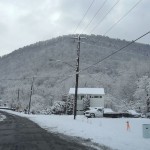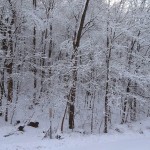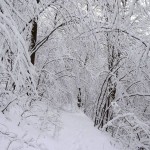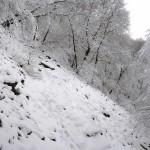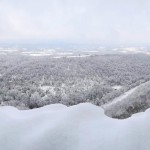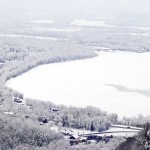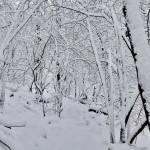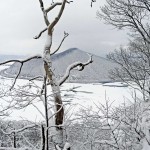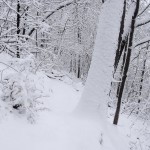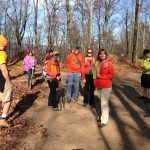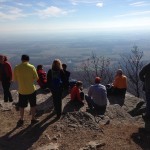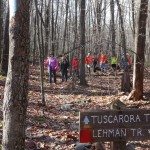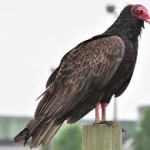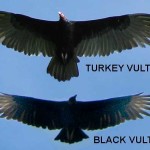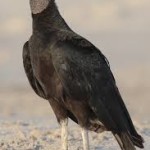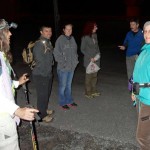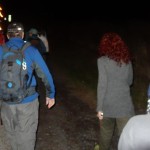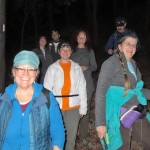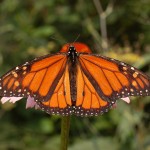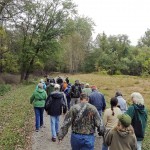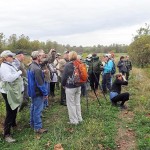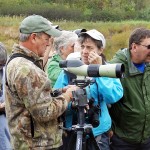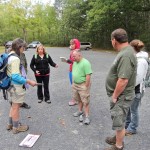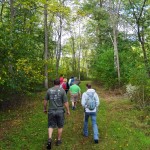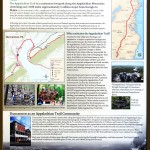Here are a few pictures from my latest trip up to Cove Mountain in Duncannon, PA.
Category Archives: Interesting
Duncannon Outdoor Club December Hike
- The Trackers!
- The Tracks
- The Trackers Making Tracks.
 The DOC had great weather for a great day. It was warm but not so warm that the snow melted. Consequently, we got to learn about and identify a number of different animal tracks.
The DOC had great weather for a great day. It was warm but not so warm that the snow melted. Consequently, we got to learn about and identify a number of different animal tracks.
Prior to our start a hunter warned us to keep an eye out for a mother bear with two cubs. Apparently, momma bear was not happy with him and approached him earlier in the week. We found no bear tracks, but then we did make a lot of noise as we sang Jingle Bells while climbing the mountain.
We did see a lot of tracks: turkey, fox, deer, squirrel, raccoon, and voles ( We scooped the snow off the top of the vole tunnels to see their tracks.). We also saw a number of tracking clues such as scats , digs, debarking, trails, and hair. The debarking was more likely caused by a porcupine since it was high up in the tree, higher than if a rabbit had done it. The deer hair and snow markings were indicative of a hunter who was dragging out his or her kill.
Three out of the four basic animal tracking gaits were observed: Straight Walker, Hopper, and Waddler. We did not see any Bounders. Straight Walker is the most common gait for Continue reading
All I Want for Christmas
Christmas is a time for celebrating life. A time for family, friends, and loved ones to connect with one another. This celebration comes just once a calendar year. Celebrating with the people you care the most about can bring memories that will last a lifetime. Memories that you can relive every day that follows. They are the kind of memories that a grandfather tells to his grandchildren. The kind of experiences you write about in your journal, Christmas cards or even, in this day, your social media page. These memories are sometimes captured by a photo but more often than not an experience that escapes the camera and can only truly be remembered with a look into the eyes of the person you were with at the time. The eye contact you make with that special person can take you right back to the place you were in the story that you are reminiscing about. Sharing these experiences with others can be as gratifying as the time you have lived. These special moments can be found sitting around a fireplace or on the top of a mountain in the vast wilderness. Wherever you find your happiness be sure to share it with the ones in your life that mean the most to you and beyond.
Some of my most memorable moments have been found outdoors on a trail, on the water, or deep in the forest where you can feel like you are the only person to ever find this special place. These moments are sometimes experienced alone and may be a once in a lifetime occasion. It is still a story worthy of sharing but the times you have experienced with others are without a doubt the most celebrated ones. Continue reading
Duncannon Outdoor Club November Hike to Flat Rock
- Going Up
- Flat Rock Overlook
- Coming Down
The weather was beautiful for the Flat Rock Hike at Colonel Denning State Park. It was a tough climb but well worth it when we got to see the view. Unfortunately we did not see any Black Vultures since they had already migrated. We did see one Turkey Vulture in migration mode.
On the way back, Sean suggested we loop down the Tuscarora Trail to the Lehman Trail to the wheel where the trails intersect with the Flat Rock Trail down to the trail head. It proved a nice return trip. We also heard Santa’s sleigh bells in the woods which turned out to be a labrador with a bell for hunting season. The dog and its owner were both very friendly.
- Turkey Vulture
- Vulture Silhouettes
- Black Vulture
When at the top of Flat Rock we took a few minutes to discuss the differences between the Black Vulture and Turkey Vulture. The Turkey Vulture being about 30 inches in length, with wingspans up to 6 feet while the Black Vulture is approximately 24 inches in length, with a wingspan less than 5 feet. The Turkey Vulture has a long tail and the Black Vulture has a shorter tail. These differences allow the Turkey Vulture to soar the thermals better than the Black Vulture. A Turkey Vulture holds its wings in a “V” during flight, rarely flaps and wobbles while soaring. The Black Vulture will flap its wings more, does not wobble and Continue reading
Duncannon Outdoor Club Moonlight Hike
 Our moonlight hike was a success even though Mother Nature did not cooperate. We rescheduled for Sunday and had clear skies and a beautiful view of the Moon and the valley below. We also had quite a surprise when two shining eyes observed us very closely from a bush along the trail. Fortunately, it was a deer blinded by our lights and just stood there for us to observe. At least it wasn’t a coyote or bear.
Our moonlight hike was a success even though Mother Nature did not cooperate. We rescheduled for Sunday and had clear skies and a beautiful view of the Moon and the valley below. We also had quite a surprise when two shining eyes observed us very closely from a bush along the trail. Fortunately, it was a deer blinded by our lights and just stood there for us to observe. At least it wasn’t a coyote or bear.

Once at the top of Peter’s Mt. the 8 phases of the Moon and other aspects were discussed: The lunar phases are created by changing angles of the Earth, Moon and Sun as the Moon orbits the Earth. Starting with the New Moon, when the Moon is between the Earth and Sun with the lit side facing away from Earth, the moon is dark and cannot be seen easily. The next phase, the Waxing Crescent, is a sliver of light less than half full. ( Waxing means getting larger with crescent meaning less than half.) The 3rd phase, the 1st quarter or half moon, is just that half full. (Quarter refers to the extent of the Moon’s cycle around the Earth, not its shape.) Waxing Gibbous is the 4th phase with gibbous meaning more than half. The Full Moon phase is the 5th phase, with the Earth between the Sun and Moon, and from that point the Moon begins to wane, decrease in size. From there you have the Waning Gibbous, 6th phase, Third Quarter, 7th phase, and Waning Crescent your last phase. These are the 8 phases of the moon in the Western Culture. Non – Western cultures may use a different number of Moon phases, for example there are a total of Continue reading
Where Have All The Monarchs Gone?
- Female Monarch Butterfly
- Monarch Caterpillar Feeding
- Male Monarch Butterfly
Have you seen any Monarchs this year in Pennsylvania? Probably not. The Monarch population is decreasing at an alarming rate! Why?
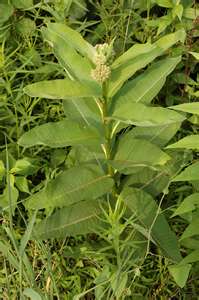 Monarch butterflies need nectar from flowers and the Monarch larva (caterpillar) only eats milkweed. Unfortunately 90% of milkweed and Monarch habitat occurs within agricultural areas and these areas are disappearing due to development. The use of herbicides is another contributing factor to disappearing habitat. The use of herbicides in farming is eradicating the milkweed because milkweed is poisonous and farmers do not want it in their fields. A milkweed plant bound in a bale of hay or eaten by a grazing cow can result in disastrous consequences. The poison, however, is beneficial to the Monarch. The Monarch’s bright orange color warns birds that it is poisonous. The caterpillar only ingests milkweed, consequently during the final stage the butterfly is poisonous. The milkweed plant also grows frequently along roadsides where herbicide sprays and cutting are used to kill roadside growth. Weather has also been unkind to the Monarchs. Migration, life cycle stages, and winter habitat are influenced by weather conditions. The 4th generation of Monarchs migrate from Pennsylvania to Continue reading
Monarch butterflies need nectar from flowers and the Monarch larva (caterpillar) only eats milkweed. Unfortunately 90% of milkweed and Monarch habitat occurs within agricultural areas and these areas are disappearing due to development. The use of herbicides is another contributing factor to disappearing habitat. The use of herbicides in farming is eradicating the milkweed because milkweed is poisonous and farmers do not want it in their fields. A milkweed plant bound in a bale of hay or eaten by a grazing cow can result in disastrous consequences. The poison, however, is beneficial to the Monarch. The Monarch’s bright orange color warns birds that it is poisonous. The caterpillar only ingests milkweed, consequently during the final stage the butterfly is poisonous. The milkweed plant also grows frequently along roadsides where herbicide sprays and cutting are used to kill roadside growth. Weather has also been unkind to the Monarchs. Migration, life cycle stages, and winter habitat are influenced by weather conditions. The 4th generation of Monarchs migrate from Pennsylvania to Continue reading
Haldeman Island Waterfowl Hike
- Access to Haldeman Island is usually restricted.
- Land Management Group Supervisor Scott Bills addresses the group at the start of the tour.
- Our group heads out to explore Haldeman Island.
- Everyone took turns looking through the scopes to get closeup views of the birds.
- Stopped to take a look at smaller birds flitting through the brush.
- Scott Bills and Deb Takach of the Duncannon Outdoor Club discuss bird identification.
We held our Haldeman Island Waterfowl Hike on October 13th and it was a great success. 25 of the 29 registrants arrived on time and ready to explore this rarely seen island located at the confluence of the Susquehanna and Juniata rivers. Our group was comprised of birding enthusiasts, curious kayakers, families out enjoying a day in the fresh air and people just interested in learning more about this exclusive island.
The 990 acre (about 1.5 square miles) Haldeman Island was previously quarried by Pennsy Supply and was later sold to the PA State Game Commission in 1990. The quarries on the northern half of the island were filled with water, and small islands were built within the ponds to foster Canada Geese. Unfortunately the Canada Goose program didn’t work out very well but the Bald Eagle program which followed was an enormous success.
We probably saw about 16 different immature bald eagles throughout the morning and once spotted no less than 6 eagles within the view of a single spotting scope Continue reading
DOC Sumacade Hike

On September 14th the Duncannon Outdoor Club (DOC) sponsored a 2.43 mile hike at Little Buffalo State Park in search of staghorn sumac. We did find a small tree too young to bear fruit. During the hike, those in front were treated to a doe and her fawn.
Prior to hiking we discussed the difference between Poison and Staghorn Sumac. Poison Sumac can be found in swampy, wooded areas and bears white berries. Staghorn is located in sunny areas along fields and roads. Staghorn has red berries in a cone shape and soft velvety fuzz on the branches similar to the velvet on a stag’s horns (correctly known as antlers). The bare branches in winter also resemble a stag’s horns, hence the name, “Staghorn Sumac”. Remember the phrase: “White means fright – red delight”.
We also dicussed The Tree of Heaven since it looks similar to sumac. The Tree of Heaven is an invasive species from China that bears light yellow flowers that hang down and turn into green seed pods changing to brown in the fall.
After the hike, participants had the opportunity to make Sumacade. They soaked the berries in water for 10 minutes, strained the water and added sugar to individual tastes.
Our next hike will be on October 19th for a moonlight hike. Come learn about waxing, waning, quarter and gibbous moon phases. Hope to see you there.
Appalacian Primitives and the Joy of Giving
“Appalacian Primitives” is an outlet for Sheldon Ott’s generosity. After retiring in 1997,he spends his spare time building rough primitive furniture with an inner beauty that suits his utilitarian aesthetic and then distributing it to people at a price near the cost of materials or, as is often the case, for free. Appalacian Primitives has donated over 50 different pieces of furniture to various groups throughout the Duncannon region such as community parks, church fundraisers, auctions for charities and generally anyone Sheldon takes a liking to.
The Duncannon Appalachian Trail Community has been fortunate enough to receive one of his tables as a gift and we will be raffling it off during the upcoming Little Buffalo Festival on Saturday, October 5th. Simply stated, it’s a couch/hall/television table made form distressed old walnut barn planks with a teak oil finish but we think it’s so much more than Continue reading
New Appalachian Trail Informational Signs in Duncannon
- Duncannon became an “official” Appalachian Trail Community in 2012
New signs paid for by the Mountain Club of Maryland provide history and information about the Appalachian Trail in Duncannon. Be sure to stop by the Old Sled Works to check them out. The text on the signs is as follows:
Appalachian Trail
across the Susquehanna River
The Appalachian Trail is a continuous footpath along the Appalachian Mountains stretching over 2180 miles (approximately 5 million steps) from Georgia to Maine. It was conceived in 1921, completed in 1937, and designated as the first National Scenic Trail in 1968. It is the nation’s longest, most accessible National Park, passing through or near more than 100 communities along the eastern seaboard, including the Borough of Duncannon, and serving nearly 3 million hikers a year. The A.T. is marked in both directions by white-paint blazes on trees, posts, and rocks. Following more than 3 decades of land protection by state and Federal agencies and private land conservancies, the Appalachian Trail corridor now forms a slender greenway that connects more than 75 public land areas in 14 states. It is a haven for biological diversity, protecting more than Continue reading

